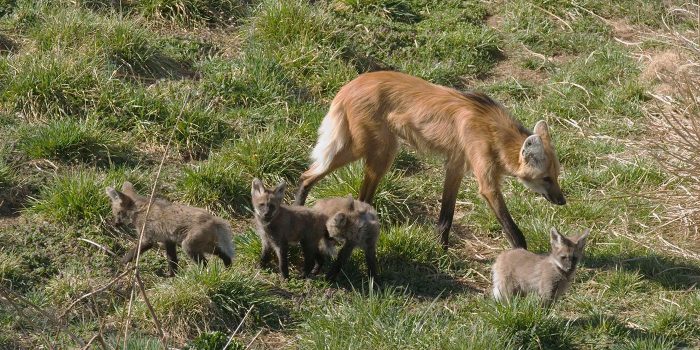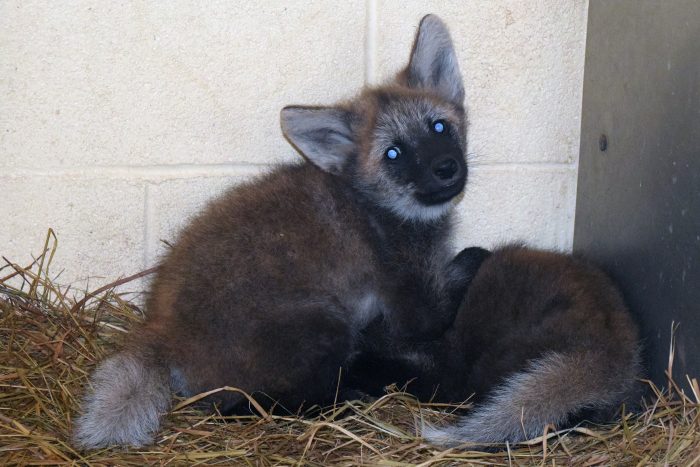And now for the mane event!
It’s a girl! It’s a boy! We’re celebrating the birth of two rare maned wolf pups at the Conservation Biology Institute in May. Amy Rogers Nazarov spent some time with the head of the Zoo’s Canid Conservation Program to learn more about these mysterious animals, who look more like foxes than wolves but actually are neither.

Having evolved to live in high grass savannas, maned wolves have a thick red coat, long black legs and tall, erect ears. The maned wolf is the largest canid of South America. Although it looks more like a long-legged fox than a wolf, genetic studies show that it is neither, but a distinct species. It is the only member of its genus, Chrysocyon. (Photo courtesy National Zoo)
The birth of a pair of maned wolf pups at Smithsonian Conservation Biology Institute on May 4 was cause for celebration among staff across the Institution. The twins’ mother is Layla, age 2; their father is Santiago, age 6. (The pups themselves have not yet been named.)
Researchers examined Layla and Santiago’s pedigrees in order to determine whether the pair were likely to produce healthy offspring. The animals evidently felt mutual canid chemistry; they mated the old-fashioned way, in secret as is their inclination, obviating the need for artificial insemination.
Maned wolves—with a mane-like strip of fur running down their heads and necks—are a specialty of sort for the Institute. Since 1974, SCBI has managed a successful program overseeing maned wolf breeding, with at least 50 pups born over the years, said Dr. Nucharin Songsasen. She is a reproductive biologist at SCBI, director of the Canid Conservation program there and a member of the team that oversees the maned wolf population and other animals (two more live downtown at the Smithsonian’s National Zoological Park).
No matter what, breeding maned wolves (or any species) involves guesswork and risk. The animals simply may not like each other and refuse to mate (in which case artificial insemination might be attempted). They might mate, but not conceive. Or, even after a successful delivery, the maternal instinct simply doesn’t kick in: wolves may shun or even eat the new pups.
Researchers examined Layla and Santiago’s pedigrees in order to determine whether the pair were likely to produce healthy offspring. The animals evidently felt mutual canid chemistry; they mated the old-fashioned way, in secret as is their inclination, obviating the need for AI.
By all accounts, Layla’s 65-day gestation and delivery proceeded without problems and she is bonding well with her pups.
Once the pups were born, no one had any contact with them for nearly seven weeks, in order to foster instinctive bonding processes between parent and children and to minimize any stress the new mother might have been feeling. A camera discreetly mounted on the wall of the den revealed—to animal keepers’ relief— that Layla was an attentive first-time mom.

Most information on maned wolf breeding has come from the study of animals in human care. The mean number of pups produced is 2.5 (with a range of 1 to 5) with a gestation period of 65 days. Females are responsible for raising pups, but there is evidence that males provide food to their pups in both zoo and wild populations. The pups nurse for four weeks at which point the mother introduces regurgitated food. Pups generally leave the parents’ territory at one year of age. (Photo courtesy National Zoo)
“She took very good care of her pups,” Dr. Songsasen said. “She would lie there and let them nurse, then come out [of the den] to eat and go to the bathroom, then go right back to them.”
In the weeks following the birth, Santiago’s role was minimal. But now that the pups have weaned from their mother, his fatherly instincts have kicked in and he has started feeding the pups (via regurgitation) and teaching them how to hunt for food.
Fatherhood can alter a male wolf’s personality, just as motherhood can change a female: Dr. Songsasen recalled another male who was “laid-back and friendly” until his pups were born, and he started to display aggression toward people he perceived as a threat to his offspring.
Parenting at this point falls largely on Santiago’s furry shoulders. “Layla is pretty much done with them by now,” Dr. Songsasen says, noting that this is how the family dynamic would typically play out in nature.
In reproduction and all other facets of the canids’ lives, SCBI staff is careful to avoid any type of interaction that mimics how a domestic dog owner might engage with her animals. “We don’t pet them,” she says. “These guys are not pets. We want to preserve their natural instincts.
“I didn’t interact with Layla a lot, but I did interact with her poop,” adds Dr. Songsasen with a chuckle. It was actually from hormones extracted from a fecal sample that she determined that Layla had probably conceived in March.

These seven-week-old siblings were born May 4 at the Smithsonian Conservation Biology Institute in Front Royal, Va. (Photo taken June 21 by Nucharin Songsasen)
On staff since 2002, Dr. Songsasen was hired specifically to launch the Canid Conservation program. The term “canid” refers to mammals, such as the maned wolf, who belong to the dog family; other species in this group at SCBI and NZP include the red wolf and the African wild dog.
“I always knew that helping to save wildlife was my passion,” said Dr. Songsasen, who worked at NZP’s Center for Species Survival prior to SCBI. She acknowledges that breeding attempts with some endangered species are not always as successful as Layla and Santiago’s efforts have been.
“Every time [we breed animals], we learn something new,” she explains. “We don’t shy away from problems; in fact, we love to tackle problems. We always think positively and stay optimistic about the future,” and from what pairing the next pup might come.
Watch Wild Inside the National Zoo: The Future of Maned Wolves from the Smithsonian Channel.
Posted: 6 July 2017



